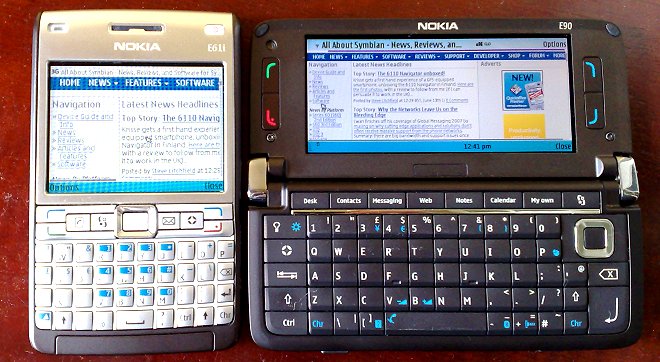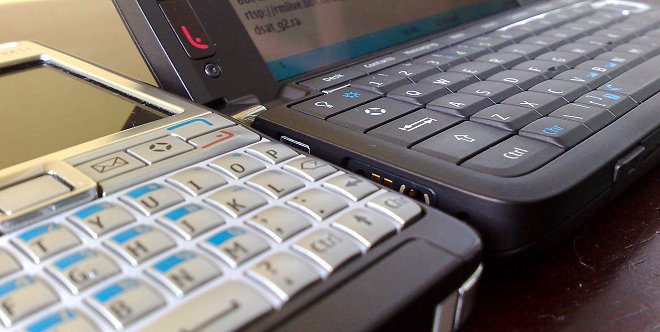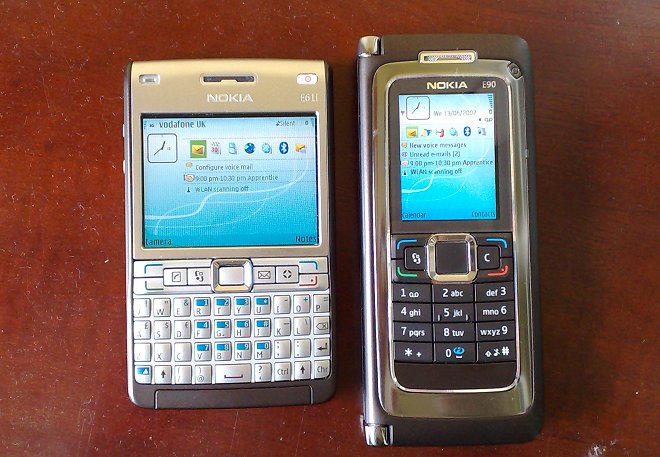To say that I've always had a fascination with gadgets and form factors is something of an understatement, starting with the Psion Series 3 and working my way through Series 5/5mx, Palm III, IIIc, Treo 180 and 270, Sony Ericsson P800/P900, Nokia 9210i and 9500, culminating in the creation of my now reasonably well known Grid, letting everybody get help in choosing the right device for them.
Today, in 2007, we have more form factors than ever before, from touch-screen tablets through slide-keyboarded superphones to the buttoned extravaganza that is the Nokia E90 Communicator. One of THE chief decisions to be made when selecting your next device is whether to go touch-screen (a la iPhone or many Windows Mobile-powered designs) qwerty (e.g. the Nokia E61i or HTC Excalibur) or keypad (e.g. the Nokia N95 and N76). Summarising the choice of interfaces:
| Touch-screen, with finger or stylus input | Qwerty keyboard | Traditional keypad and predictive text | |
| Text input speed | Slow | Can be quite fast, depending on | Relatively slow |
| Handedness | Two hands needed | Two hands needed | One hand input practical |
| Strong points | Simpler GUI possible, easier to learn, device can be smaller | Fast text input on the road | Device can be very small, traditional phone form, etc. |
Despite the many, many attractions of the likes of the Nokia N93 and Nokia N95, I keep coming back, for my own use, at least, to the fact that I've "gotta have qwerty". And, judging by the sheer volume of keyboarded designs coming from the worlds of Windows Mobile, Palm OS and Linux, it seems that smartphone (for many) equals a proper keyboard, however miniscule.
So, with this premise set up, the two leading Symbian OS-based smartphones are arguably the Nokia E61i and the E90 Communicator. Maybe, just maybe, the Sony Ericsson P1i will compete when it finally comes out, but that's another comparison for another day. Now, it's patently obvious that the E90 outguns the E61i in every department. BUT, and it's a big 'but', the E90 is also double the price.

Note the side by side view. The E90's display is 50% wider than the E61i's but with 150% extra resolution, meaning that Web browsing (for one) is significantly more convenient
So, predictably, it all comes down to how much value you'll get from the differences between the two devices. To help make that choice, here's the definitive E61i/E90 breakdown:
| Nokia E61i | Nokia E90 |
| Price:£250 plus VAT | Price:£500 plus VAT |
| One piece sturdy (metal and plastic) design, single 2.8" by 320 by 240 landscape display | Clamshell hinged design, sturdy (metal and plastic), dual displays, larger 4", at 800 by 352 pixels |
| Weight: 150g | Weight: 210g |
| 20MB free RAM, 220MHz processor (for the E61i's use, 20MB is usually enough, it's on the likes of the N95 with the huge camera that 20MB looks stingy for RAM) | 80MB free RAM(!), 330 MHz processor, with graphics acceleration (yes, both these stats are as wonderful as they sound, the E90 flies through most tasks quickly - and it's great not ever having to close an app down for RAM reasons!) |
| Pop port for USB connectivity and stereo audio out (Pop port is starting to look like more and more of an anachronism these days, and you'll need a special adapter in order to plug in any kind of standard headphones) | miniUSB for connectivity and 2.5mm jack for stereo audio out |
| microSD expansion | microSD expansion |
| Three hardware buttons for app launching, plus the usual function keys (all of these feel somewhat 'squidgy' though....) | Seven, arguably more hardware buttons for app launching/switching (the E90's build quality extends to all buttons) |
| Qwerty keyboard, 2.25" 'Q' to 'P', always available (as good as thumb keyboards get, but they always feel cramped and your fingers will fight for space when trying to type fast) | Qwerty keyboard, 3" 'Q' to 'P', qwerty available when clamshell is open (as already stated on AAS, the E90 keyboard is compact, well built and functional, but won't allow for much more than two finger or two thumb typing. It's faster than the E61i's though, if only because there's more finger room...) |
| 2 megapixel camera, fixed focus, no flash (fixed focus is a right pain when you're trying to get close-up to something to shoot it in detail, but a blessing when shooting family and friends ad-hoc. Picture quality is similar to that from other Nokia 2 mp cameras) | 3 megapixel camera, autofocus, flash (generally excellent, see here for samples) |
| CIF video recording, 15fps (as on the Nokia N70, E70 and many previous devices, CIF isn't really up to serious use, although it's still miles better than video on many other phones) | VGA video recording, up to 30fps (quality isn't quite as good as on the Nokia N93, but still more than acceptable for home movie use) |
| Mono loudspeaker (not really suitable for any kind of music use) | Stereo loudspeakers (great quality, even for music, although no real stereo separation!) |
| AAC, eAAC+ and MP3 music formats supported | AAC, eAAC+, MP3 and WMA music formats supported (WMA support is particularly nice to have, as it means that Windows Media Player can be used for ripping for both desktop and smartphone) |
| No radio | FM radio |
| No GPS | Built-in low power TI-made GPS (although lock-on times are much slower than if a standalone Bluetooth GPS were used) |
| S60 3rd Edition | S60 3rd Edition Feature Pack 1 |
| Full HP-centric printer support in all applications | Same, full HP-centric printer support in all applications |
| No 'Active notes' | 'Active notes' application, saving object-based notes straight to HTML (a new application, the usefulness of this has yet to be proven...) |
| Battery life generally excellent | Battery life generally good, considering the extra RAM involved, the larger display, GPS and camera. |

Key travel is about the same, but the E90's keys are significantly larger and thus more widely spaced
At first sight, the E61i and the E90 seem to be fairly close in terms of capabilities, especially in terms of software and core functions, but the gradual one-upmanship of the new Communicator's hardware over its flatter relative really starts to add up. Traditional PDA 'power' users and anyone interested in doubling up work use with multimedia will be sure to grab the E90; for everyone else, the E61i will do many of the same messaging-centric jobs at half the price - work through the table above in order to get a feel for which camp you're in.

Closed, despite the thickness and weight differences, the E90 somehow feels smaller...
Steve Litchfield, 13 June 2007
